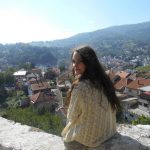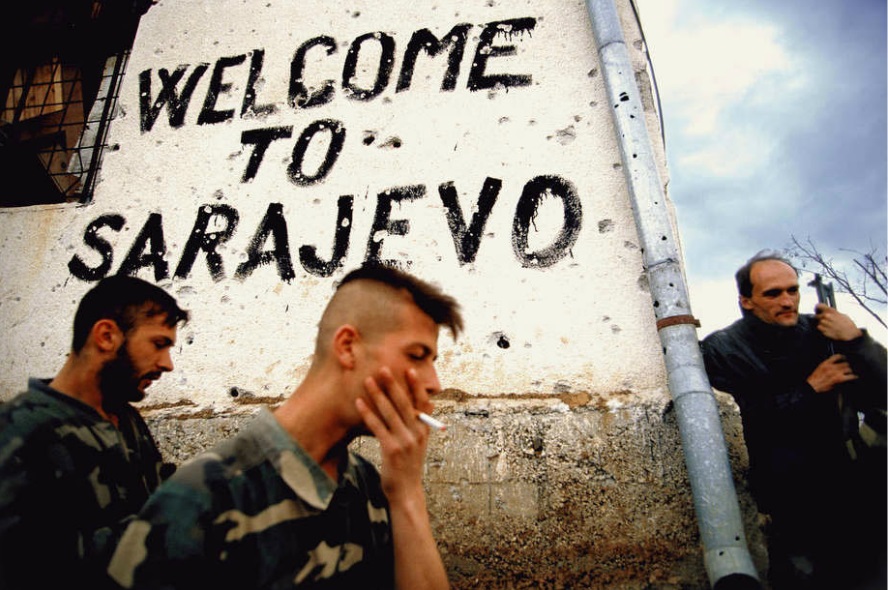
American photographer, Ron Haviv, spent 10 years documenting the Balkan wars. His work was used as evidence for prosecuting war criminals. An exhibition of his work Blood and Honey: a Balkan War Journal is being held in the Srebrenica Gallery in Sarajevo until April 2016.
Ron Haviv has spent almost 25 years documenting conflicts around the world, from the wars in Bosnia and Rwanda to the famine in Somalia. He spent 10 years photographing the Balkan wars, taking some of the most famous photographs of the Bosnian war. We met in Sarajevo, where an exhibition of his war photography, called Blood and Honey: a Balkan War Journal, is being held at the Srebrenica Gallery until April 2016.
“As a photographer and journalist, I grew up in the former Yugoslavia. I learned my lessons about how to tell stories, about the power of photography and the implications of photography, I made great friends here, and I lost friends here,” says Haviv, explaining his strong connections, particularly to Bosnia. When the war started in 1992, Ron Haviv was 27 years old. He had been an international photographer for almost two years.
“I already had some experience in the impact of photography, and I thought it could have a bigger impact than it did.” In Bosnia he learned of the limitations his wartime images would have in eliciting a response that could change the future course of events. In the spring of 1992, before the war had officially started, he photographed Muslim civilians being kicked, beaten and killed by Serb forces in Bijeljina. “I thought the photographs would serve as visual proof of the brutality: here are unarmed, middle aged men being executed in the streets. [But] there was no reaction whatsoever.” Haviv felt “extremely disappointed”.
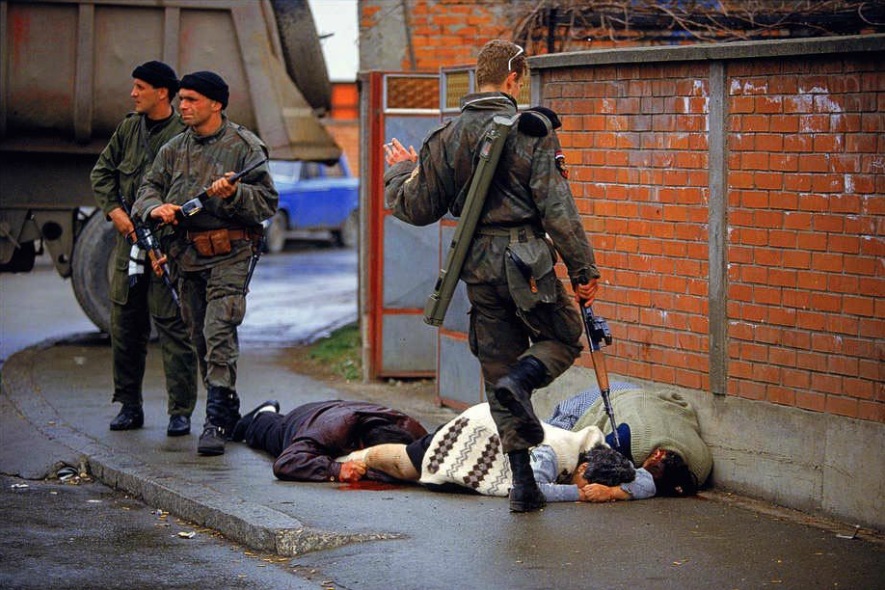
Later, while working in Sarajevo, Haviv and his colleagues continued to feel frustrated by the lack of response they were receiving to their documentation of wartime atrocities. He recalls, “The most disappointing thing was that, by 1993, people would see us with cameras, come up to us and say, ‘You should go home, we don’t want you here.’ We were representatives of the West and they were expressing their frustration with what was happening.” With so many journalists and photographers being wounded and killed, many did, in fact, decide to leave Bosnia.
But Haviv made the decision to stay. “It was important to document [the war]. Since I had been there from the beginning, I wanted to see it through to the end. It was important to create this body of evidence in order to hold people accountable.” Even though he came to realize his photographs might not create a significant reaction, he still believed in the impact they could have, some of which he could not have predicted. He cites General Divjak as an example. Jovan Divjak was a Bosnian Serb general considered to be “one of the great defenders of Sarajevo”, Divjak told Haviv that when he saw his photographs of Bijeljina “he couldn’t fight alongside the Serbs”. “I’m sure there were many other factors involved in his decision, but this is the beauty of photography. You put it out into the world, and you have no idea how it will affect others.”
Although his images didn’t stop the war, Haviv’s continued documentation of the atrocities led to perhaps the most significant impact of his work. His photographs were used in prosecuting war criminals at the International Criminal Tribunal for the former Yugoslavia (ICTY) in The Hague, one example being the indictment of Zeljko Raznjatovic Arkan, commander of an elite unit known as the Tigers.
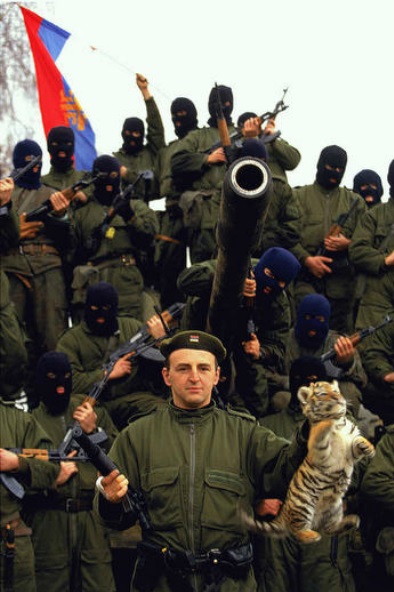
Haviv photographed Arkan in the fall of 1991, and, after gaining his trust, was later able to accompany the Tigers while they were fighting. He photographed the soldiers executing civilians in Bijeljina, and when the pictures were published, Arkan put Haviv on a death list. “He said he looked forward to the day he could drink my blood.” Haviv spent the next eight years trying to avoid Arkan. “I was very lucky not to see him [again].”
In the fall of 1995, Haviv followed the Fifth Corps in Bosnia, one of the Republic of Bosnia and Herzegovina’s seven army corps, which was mostly made up of soldiers who were fighting to take back their villages that had been lost in 1992. A young soldier named Senad Medanovic took Haviv to his village where he found his house in ruins. He was the sole survivor of a massacre that killed 69 of the village’s inhabitants who were buried in a mass grave in his front yard.
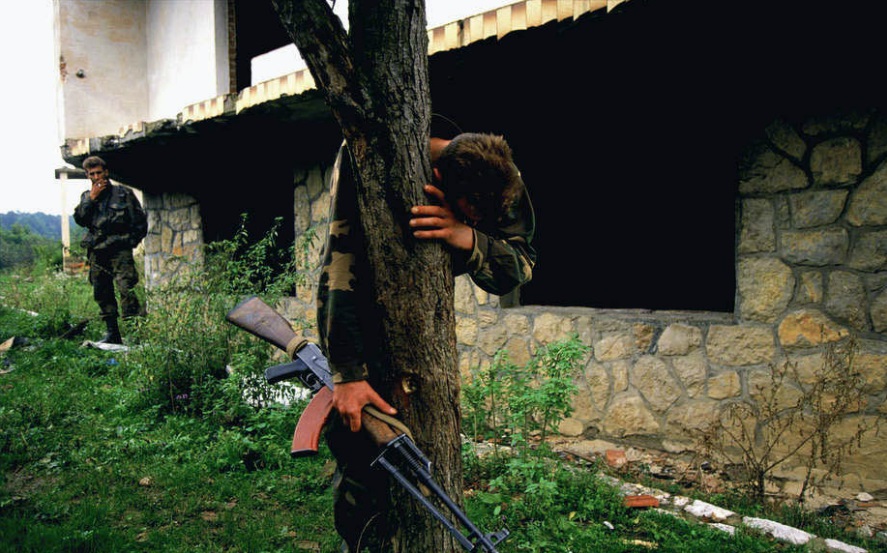
“As we were leaving, he was overcome with emotion and just collapsed on a tree and started crying,” Haviv recalls. He was able to return to his village but there was nobody living there. He was the sole survivor.”
As a war photographer, Ron Haviv has witnessed the worst that mankind has to offer. After documenting the genocides in Bosnia, Rwanda and Darfur, he admits, “I don’t have a huge amount of faith in humanity. I see what people can do to each other and it’s pretty shocking.”
Yet, he has witnessed acts of heroism, tenderness and kindness, and this gives him hope. “When you see these little moments when somebody is trying to help someone else, or even when you just see the bravery of trying to live a normal life during the war… I’m overwhelmed by humankinds’ resilience and desire to survive,” the photographer says.
In Sarajevo, “when people were wounded or in the midst of sniper fire, a complete stranger would run into the middle of the street to save them from the line of fire and then take them to Kosevo [Hospital],” Haviv recalls. People would risk their own lives to help complete strangers “by instinct and bravery.” This gave him hope.
According to Haviv, it’s not only the commanders or politicians who give the orders, or the soldiers who carry out the orders, who need to be held accountable. It is also the general public. His work hold accountable all those who did nothing as thousands were killed and millions were forced to flee the country.

Committed to documenting conflicts and raising awareness on human rights issues, Haviv says, “It’s a privilege for me … to watch history unfold and to be able to show the world what I witnessed.” After returning to visit Bosnia, Haviv says he is “happy to see that there is no fighting and that people are somewhat coexisting,” but he also feels “extremely disappointed that Bosnia has not moved much further forward than it was at the end of the war.” The divisions are still prevalent, not only among people, but also within the government. Haviv thinks this is “very disrespectful” to all the people who lost their lives on all sides. He hopes the politicians will do a better job with this “new push towards the EU” and under “pressures by the people”.



